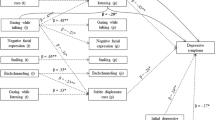Abstract
High and low socially-skilled adolescents, ranging in age from 11 to 16 years, were led to be verbally deceptive or truthful about their enjoyment of a drink that either tasted good or bad. Short, silent videotaped samples of the adolescents while they were being deceptive or truthful were shown to a group of judges, who were asked to indicate how much each adolescent actually enjoyed the drink on the basis of their nonverbal behavior. Results indicated that, as predicted, adolescents with higher levels of social competence were generally better at deceiving than adolescents of lower social competence. However, these findings held primarily for younger adolescents. Furthermore, older adolescents were better at being deceptive than younger ones, and younger females were more proficient liars than younger males.
Similar content being viewed by others
References
Achenbach, T.M., & Edelbrock, C.S. (1982). Manual for the Child Behavior Checklist and Child Behavior Profile. Burlington, VT: Child Psychiatry, University of Vermont.
Achenbach, T.M., & McConaughy, S.H. (1997). Empirically based assessment of child and adolescent psychopathology. (2nd ed). Thousand Oaks, CA: Sage.
Beck, L., & Feldman, R. S. (1990). Enhancing children's decoding of nonverbal behavior. Journal of Nonverbal Behavior, 13, 269–277.
Buller, D.B., & Burgoon, J.K. (1997). Emotional expression in the deception process. In P.A. Andersen & L.K. Guerrero (Eds.), Handbook of communication and emotion: Research, theory, applications, and contexts. San Diego, CA: Academic Press. Pp. 381–402.
Coats, E.J., & Feldman, R.S. (1996) Gender differences in nonverbal correlates of social status. Personality and Social Psychology Bulletin, 22, 1014–1022.
Coats, E.J. (1996). Nonverbal expressions of emotion: Two models of gender and status differences. Unpublished doctoral dissertation, University of Massachusetts at Amherst.
Custrini, R.J., & Feldman, R.S. (1989). Children's social competence and nonverbal encoding and decoding of emotions. Journal of Clinical Child Psychology, 18, 336–342.
DePaulo, B.M. (1991). Nonverbal behavior and self-presentation. In R.S. Feldman & Rimé, B. (Eds.), Fundamentals of nonverbal behavior. Cambridge, England: Cambridge University Press.
DePaulo, B.M. (1994). Spotting lies: can humans learn to do better? Current Directions In Psychological Science, 1, 83–86.
DePaulo, B.M., Kashy, D.A., Kirkendol, S.E., Wyer, M.M., & Epstein, J.A. (1996). Lying in everyday life. Journal of Personality and Social Psychology, 70, 979–995.
Doll, B., Furlong, M.J., & Wood, M. (1998). Reviews of the Child Behavior Checklist. In O.K. Buros (L.L. Murphy, Ed.), Thirteenth mental measurements yearbook. Lincoln, NE: Buros Institute.
Edwards, R., Manstead, A.S.R., & MacDonald, C.J. (1984). The relationship between children's sociometric status and ability to recognize facial expressions of emotion. European Journal of Social Psychology, 14, 235–238.
Ekman, P., Friesen, W., & Ellsworth, P. (1972). Emotion in the human face. Elmsford, NY: Pergamon Press.
Feldman, R.S., Jenkins, L., & Popoola, L. (1979). Detection of deception in adults and children via facial expressions. Child Development, 50, 350–355.
Feldman, R.S., Philippot, P., & Custrini, R.J. (1991). Social competence and nonverbal behavior. In R.S. Feldman & B. Rimé (Eds.), Fundamentals of nonverbal behavior. Cambridge, England: Cambridge University Press.
Feldman, R.S., & Philippot, P. (1991). Children's deception and social competence. In K.J. Rotenberg (Ed.) Children's interpersonal trust: Sensitivity to lying, deception and promise violations. New York: Springer-Verlag.
Feldman, R.S., White, J.B., & Lobato, D. (1982). Social skills and nonverbal behavior. In R.S. Feldman (Ed.), Development of nonverbal behavior in children (pp. 259–277). New York: Springer-Verlag.
Hall, J. A. (1984). Nonverbal sex differences: Communication accuracy and expressive style. Baltimore: Johns Hopkins University Press.
Kashy, K.A., & DePaulo, B.M. (1996). Who lies? Journal of Personality and Social Psychology, 70, 1037–1051.
Levine, S.P., & Feldman, R.S. (1998, August). Lying and self-presentation. Paper to be presented at the annual meeting of the American Psychological Association, San Francisco, CA.
Lewis, M., & Saarni, C. (Eds.) (1993). Lying and deception in everyday life. New York: Guilford.
McCown, W., Johnson, J., & Austin, S. (1986). Inability of delinquents to recognize facial affects. Journal of Social Behavior and Personality, 1, 489–496.
Philippot, P., Feldman, R.S., & Coats, E.J. (Eds.) (1999). The social context of nonverbal behavior. Cambridge, England: Cambridge University Press.
Riggio, R.E., Tucker, J., & Throckmorton, B. (1988). Social skills and deception ability. Personality and Social Psychology Bulletin, 13, 568–577.
Russell, J.A., & Fernandez-Dols, J.M. (1997). The psychology of facial expression. Cambridge, U.K.: Cambridge University Press.
Saarni, C. (1984). An observational study of children's attempts to monitor their expressive behavior. Child Development, 55, 1504–1513.
Saarni, C. (1989). Children's understanding of emotion. Cambridge, England: Cambridge University Press.
Author information
Authors and Affiliations
Rights and permissions
About this article
Cite this article
Feldman, R.S., Tomasian, J.C. & Coats, E.J. Nonverbal Deception Abilities and Adolescents' Social Competence: Adolescents with Higher Social Skills are Better Liars. Journal of Nonverbal Behavior 23, 237–249 (1999). https://doi.org/10.1023/A:1021369327584
Issue Date:
DOI: https://doi.org/10.1023/A:1021369327584




